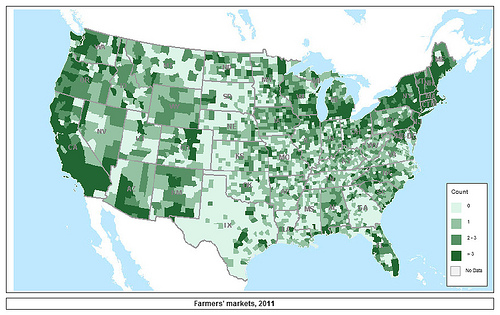
Number of Farmers Markets per County, 2011 (darkest areas have higher numbers). More than 7,800 farmers markets have sprung up across the United States, up from roughly 1,700 in 1994.
This post is part of the Science Tuesday feature series on the USDA blog. Check back each week as we showcase stories and news from USDA’s rich science and research profile.
Interest in local and regional food systems has expanded in recent years. The evidence is everywhere: from the number of farmers markets more than doubling nationwide since 2004, to the rising popularity of “community supported agriculture” (CSA) participation, to the increasingly common sight of restaurants and retail grocery outlets stocking and promoting meat and produce from local farmers and ranchers. This consumer trend has implications for the farms that supply these markets, firms across the retail supply chain, and policy makers at the federal, state and local levels that often promote local foods in various nutrition, food assistance and community development programs. Read more »
Understanding a community’s food environment is key to understanding a community’s identity. But what can a “food environment” tell us?
A community’s food environment is a technical term for assessing information about the who, what, where, and how of food availability in a given community: Who are the people in the community?
What kinds of food outlets are available in their area? How accessible are grocery stores and supermarkets? What are some of the health statistics? Read more »
This year, USDA’s Economic Research Service (ERS) celebrates its 50th anniversary. ERS was established on April 3, 1961 during the Kennedy Administration, when USDA combined the Department’s economic research functions into one agency. The functions of our predecessor agency, the Bureau of Agricultural Economics (BAE, dating from 1922), had been dispersed in 1953 to other USDA offices, and many former BAE economists found a home in the new ERS.
This week, ERS is marking the occasion with a day-long symposium in USDA’s Jefferson Auditorium, featuring speakers from government and the research community who will focus on the agency’s contributions to public policy and the social sciences. USDA employees and the public are invited to the symposium. Read more »
About this time last year, the city of Washington, DC was digging out from a record amount of snow. My colleagues at USDA’s Economic Research Service were communicating electronically to get a new web-based mapping tool – the Food Environment Atlas – up and running. This online tool, which measures a community’s food-choice landscape, was to play a key role in the launch of First Lady Michelle Obama’s Let’s Move! campaign against childhood obesity. Read more »
This week my kids headed back to school, and I’ll be busier than last year, having been drafted to be PTA president. While getting to know the new parents at our school, I learned that several are interested in improving school meals and exploring the possibility of purchasing locally and starting a school vegetable garden. Our new principal is interested too. I myself have something of a brown thumb, but everyone was excited to hear that I work at the Department of Agriculture and had have been studying Farm to School initiatives throughout the country. I have been in close touch with USDA’s Farm to School team that will visit 15 school districts across the country to learn about their Farm to School activities.
When our agency, the Economic Research Service (ERS), put together the Food Environment Atlas earlier this year, we included information on which counties had at least one Farm to School program, using data from the National Farm to School Network. The Network maintains the only national data base of Farm to School programs. After the Atlas was released on our website, we received phone calls from programs that hadn’t been included, and this underscored the need to build a complete data base of these programs. Read more »

